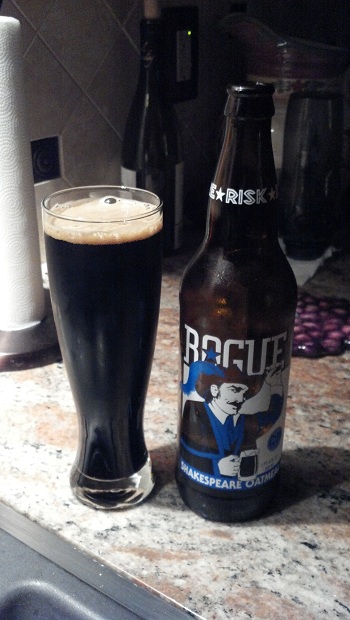"Drink, sir, is a great provoker of three things: nose painting, sleep, and urine. Lechery, sir, it provokes and unprovokes; it provokes the desire, but takes away the performance."

Brewery and Country of Origin: Rogue Ales of 2320 Southeast Osu Drive, Newport, OR, 97365, USA
Date Reviewed: 8-15-12
Turns out Shakespeare wasn't ever in our favorite school subjects list. So instead, we're going to talk about... you guessed it: BOOBS! A boob, or breast is a apocrine secreting exocrine gland. Aside from causing about 96% of the world's problems (and solutions), the primary function of the breast is to contain the mammary gland which produces milk used to feed new born babies. The basic gland units of the breast responsible for making breast milk are the Terminal Duct Lobular Units. These are the workhorse components of the breast. The TDLUs secrete into the lactiferous ducts, which act as drains for the nipple. The breast is an inhomogeneious anatomic structure composed of different layers of tissue. The glands of the breast rely solely on a balanced level of estrogen in order to produce milk. Around the nipple are 14-18 lactiferous ducts which deliver milk to the infant. These ducts are structurally supported with dense layers of connective tissue. The amount of connective tissue depends on the stage and development of a woman including menstruation, pregnancy, breast-feeding, and puberty. Connective tissue and white fat will primarily dictate the size of one's breasts. The peripheral side of the central nervous system supplies the breast with enhanced levels of sensitivity. Human females are the only promates which possess permanent, full form breasts even when not in pregnancy. Breast size also fluctuates with hormonal changes caused by thelarche, pregnancy, and the menstrual cycle. Body weight can also influence the size of the breasts, with more weight causing an increase in breast size generally. It is always important to conduct a self examination for any changes in the breast tissue concerning lumps, tenderness, swelling, and soreness/heavyness. Detecting any sudden or suspicious changes early can help prevent the spread of breast cancer, a leading cause in general death among women. Boobs impact culture and social norms immensely in the form of physical image and historical significance. Women of some cultures choose to augment their breasts by making them larger to appear more attractive, and many certain styles of clothing are worn to emphasize a woman's breasts via cleavage. Cleavage, also known as the intermammary sulcus, is the line or space between a woman's breasts exposed by clothing with low or non existing necklines. Exposing one's breast has also been used multiple times in Western society as a means of protesting equality for women. Toplessness, though mostly seen as vulgar in western civilization, can be perfectly acceptible and legal in certain contexts. The breast has been portrayed numerous times in every major world religion, and continues to be the focus of both the mainstream and pornographic media industries world wide. Sexual appeal is used to sell products, motivate certain behaviors, and spur on pop culture, among other things. But you all probably knew all of that. What you didn't know is that boobs are very fun to play with.
Date Sampled: 8-11-12 At: Amanda Lubin's House, Syosset, NY, USA
Beer Style: Oatmeal Stout
Alcohol by Volume: 6.10%
Serving Type: 22 oz Bottle, 16 oz Weizen Glass
Rating: 3.60
 Shakespeare Oatmeal Stout
Shakespeare Oatmeal Stout




